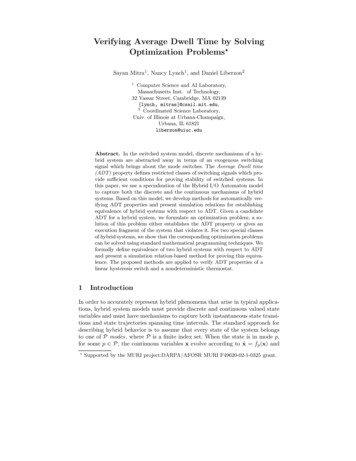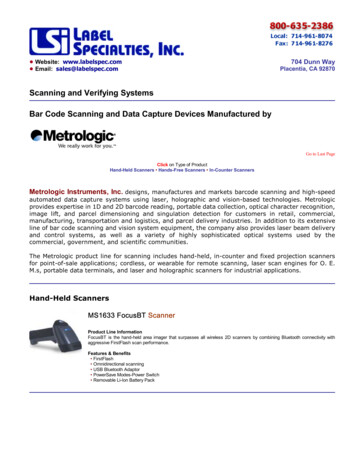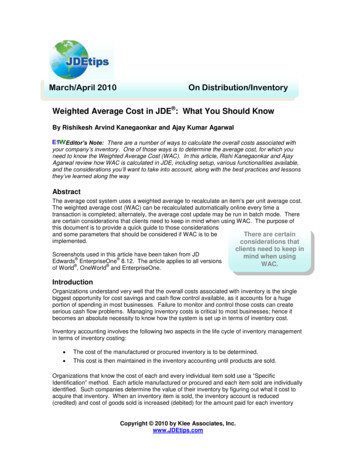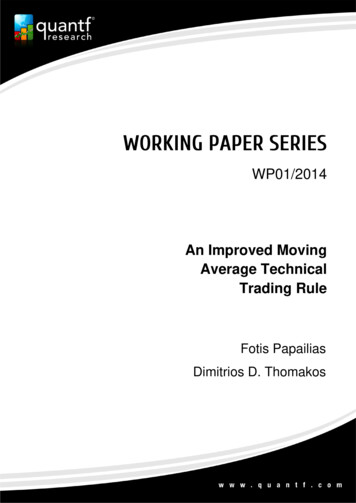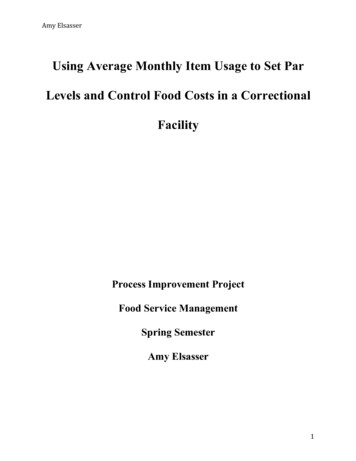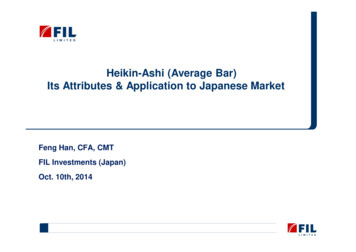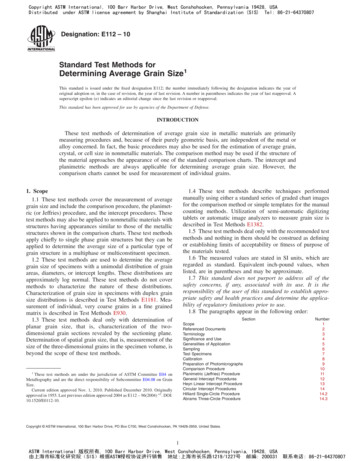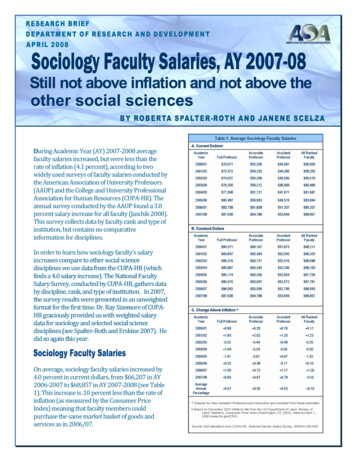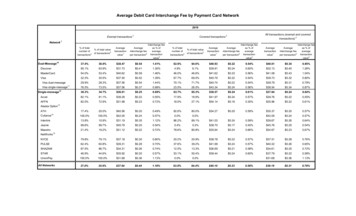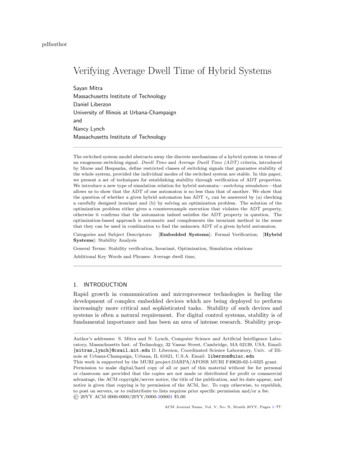
Transcription
pdfauthorVerifying Average Dwell Time of Hybrid SystemsSayan MitraMassachusetts Institute of TechnologyDaniel LiberzonUniversity of Illinois at Urbana-ChampaignandNancy LynchMassachusetts Institute of TechnologyThe switched system model abstracts away the discrete mechanisms of a hybrid system in terms ofan exogenous switching signal. Dwell Time and Average Dwell Time (ADT) criteria, introducedby Morse and Hespanha, define restricted classes of switching signals that guarantee stability ofthe whole system, provided the individual modes of the switched system are stable. In this paper,we present a set of techniques for establishing stability through verification of ADT properties.We introduce a new type of simulation relation for hybrid automata—switching simulation—thatallows us to show that the ADT of one automaton is no less than that of another. We show thatthe question of whether a given hybrid automaton has ADT τa can be answered by (a) checkinga carefully designed invariant and (b) by solving an optimization problem. The solution of theoptimization problem either gives a counterexample execution that violates the ADT property,otherwise it confirms that the automaton indeed satisfies the ADT property in question. Theoptimization-based approach is automatic and complements the invariant method in the sensethat they can be used in combination to find the unknown ADT of a given hybrid automaton.Categories and Subject Descriptors:Systems]: Stability Analysis[Embedded Systems]: Formal Verification;[HybridGeneral Terms: Stability verification, Invariant, Optimization, Simulation relationsAdditional Key Words and Phrases: Average dwell time,1.INTRODUCTIONRapid growth in communication and microprocessor technologies is fueling thedevelopment of complex embedded devices which are being deployed to performincreasingly more critical and sophisticated tasks. Stability of such devices andsystems is often a natural requirement. For digital control systems, stability is offundamental importance and has been an area of intense research. Stability propAuthor’s addresses: S. Mitra and N. Lynch, Computer Science and Artificial Intelligence Laboratory, Massachusetts Inst. of Technology, 32 Vassar Street, Cambridge, MA 02139, USA. Email:{mitras,lynch}@csail.mit.edu D. Liberzon, Coordinated Science Laboratory, Univ. of Illinois at Urbana-Champaign, Urbana, IL 61821, U.S.A. Email: liberzon@uiuc.eduThis work is supported by the MURI project:DARPA/AFOSR MURI F49620-02-1-0325 grant.Permission to make digital/hard copy of all or part of this material without fee for personalor classroom use provided that the copies are not made or distributed for profit or commercialadvantage, the ACM copyright/server notice, the title of the publication, and its date appear, andnotice is given that copying is by permission of the ACM, Inc. To copy otherwise, to republish,to post on servers, or to redistribute to lists requires prior specific permission and/or a fee. 20YY ACM 0000-0000/20YY/0000-100001 5.00ACM Journal Name, Vol. V, No. N, Month 20YY, Pages 1–?.
2·S. Mitra, D. Liberzon and N. Lyncherties are also important in distributed computation and control type applications.For instance, coordinating mobile robots starting from arbitrary locations in theplane are required to converge to some formation; a set of failure prone processescommunicating over unreliable channels are expected to perform some useful computation once the failures seize and the message delays become normal.The standard approach for describing complex embedded systems, consistingof software components and physical processes, is to assume that every state ofthe system belongs to one of P modes, where P is a finite index set. When thestate is in mode i, for some i P, the continuous variables x evolve according tosome differential equation ẋ fi (x) and the discrete variables remain constant;transitions are described by guards and reset maps. When a transition occurs, itmay alter both the continuous and the discrete variables and therefore may lead tomode change. Hybrid automata-like models (see e.g. [Alur et al. 1995; Lynch et al.2003]) embody the above point of view. Verification of safety properties of hybridautomata through reachable set computations [Mitchell and Tomlin 2000; Prajnaand Jadbabaie 2004; Kurzhanski and Varaiya 2000; Henzinger and Majumdar 2000]and deductive techniques [Mitra et al. 2003; Livadas et al. 1999; Heitmeyer andLynch 1994] have received a lot of attention in the recent years.Analyzing the stability of hybrid automata is challenging because the stabilityof the continuous dynamics of each individual mode does not necessarily imply thestability of the whole automaton. The basic tool for studying stability relies on theexistence of a Common Lyapunov function, whose derivative along the trajectoriesof all the modes must satisfy suitable inequalities. When such a function is notknown or does not exist, Multiple Lyapunov functions [Branicky 1998] are usefulfor proving stability of a chosen execution. These and many other stability resultsare based on the switched system [Liberzon 2003; van der Schaft and Schumacher2000] view of hybrid systems.Switched systems may be seen as higher-level abstractions of hybrid automata.A switched system model neglects the details of the discrete mechanisms of a hybrid automata, namely the guards and the reset maps, and instead relies on anexogenous switching signal to bring about the mode switches. Using this modelone can focus on the stability of a hybrid system with respect to its continuousdynamics, assuming that the switching signal belongs to a certain class. If the individual modes of the automaton are stable, then the Dwell Time [Morse 1996] andthe more general Average Dwell Time (ADT) criteria, introduced by Morse andHespanha [Hespanha and Morse 1999], define restricted classes of switching signalsthat guarantee stability of the whole system.To be more specific, a hybrid automaton A has ADT τa if, in every executionfragment of A, any τa interval of time, on an average, has at most one modeswitch. A large average dwell time means that the system spends enough time ineach mode, so as to dissipate the transient energy gained through mode switches.Having a large average dwell time itself is not sufficient for stability, in addition,the individual modes of the automaton must also be stable. In fact, the problemof proving the stability of a hybrid system can be broken down into, (a) findingLyapunov functions for the individual modes, and (b) checking the appropriateADT property. In this paper we assume that a solution to part (a)—a set ofACM Journal Name, Vol. V, No. N, Month 20YY.
Verifying Average Dwell Time·3Lyapunov functions for the individual modes—is known from existing techniques,and we present semi-automatic methods for proving the ADT properties. Of course,to verify ADT we have use a hybrid automaton-like model that captures both thediscrete and continuous mechanisms of hybrid systems. Thus, we provide a missingpiece in the toolbox for analysis of stability of hybrid systems.1.1ContributionsWe use the Structured Hybrid Automaton (SHA) model, derived from Hybrid Input/Output Automaton (HIOA) framework of [Lynch et al. 2003] to develop methods for verifying ADT properties. First of all, we define what it means for a givenSHA to switch “faster than” another SHA, with respect to ADT. We introducea new kind of simulation relation, called switching simulation, which gives a sufficient condition for establishing the above faster than relationship between pairsof automata. This provides us with a method for abstraction, particularly gearedtowards ADT verification. That is, if automaton A1 is simulated by a faster automaton A2 , and A2 has ADT τa , we can conclude that the ADT of A1 is at leastτa .Our first method for ADT verification relies on checking invariant properties. Inorder to check if automaton A has ADT τa , we transform it to a new automaton A(τa ), such that, A has ADT τa if and only if A(τa ) has a particular invariant property I(τa ). We can then appeal to suitable invariant checking tools, likeHyTech [Henzinger et al. 1997], PHAVer [Frehse 2005] or PVS [Owre et al. 1996],to check I(τa ). This method is applicable to general SHAs, however, the invariantI(τa ) can be checked automatically only for restricted classes of automata; for hybrid automata that are outside these classes, semi-automatic deductive techniquescan be used.Our second method ADT verification is based on solving an optimization problem. To check if automaton A has ADT τa , we formulate an optimization problemOPT(τa ). From the solution of OPT(τa ) we either get a counterexample executionfragment of A that violates the ADT property τa , or else we get a proof that no suchcounterexample exists, and that A has ADT τa . We show that for certain classes ofSHAs OPT(τa ) can indeed be formulated and solved using standard mathematicalprogramming techniques. The optimization-based method complements the invariant method because the two can be combined to find the ADT of SHAs. Switchingsimulation relations together with the two verification methods, are used to verifythe ADT properties of several typical hybrid systems.1.2OrganizationThe rest of the paper is organized as follows: in Section 2 the Structured HybridAutomaton (SHA) model is formally introduced and briefly compared to otherexisting models; the linguistic conventions used throughout the paper for describing SHAs are presented; stability and Average Dwell Time (ADT) properties ofSHAs are defined. The section concludes with the theorem which provides sufficient conditions for establishing equivalence of SHAs with respect to ADT basedon switching simulation relations. Section 3 presents the invariant-based approachfor verifying ADT. First, the necessary transformations are presented and thenthe invariant-based ADT verification of two hybrid systems—a scale-independentACM Journal Name, Vol. V, No. N, Month 20YY.
4·S. Mitra, D. Liberzon and N. Lynchhysteresis switch and a leaking gas burner—are described. Section 4 presents theoptimization-based method for verifying ADT. At first, the optimization problemOPT corresponding to ADT verification is stated. It is established that for initialized rectangular SHAs and more restricted one-clock initialized SHAs, OPT canbe solved effectively. These results, along with switching simulation relations areused to automatically verify ADT of a linear hysteresis switch and a thermostatwith nondeterministic switches. For initialized rectangular SHAs, a Mixed Integer Linear Program formulation for solving OPT is presented. Section 5 concludesthis paper with a summary of contributions and with some remarks on possibleextensions interesting directions for future research.2.STRUCTURED HYBRID AUTOMATA, STABILITY AND AVERAGE DWELL TIMEThis section forms the mathematical basis for the rest of the paper. First weintroduce the Structured Hybrid Automata (SHA) model, a simplified version ofthe HIOA model of [Lynch et al. 2003] tailored for the results in this paper. InSection 2.3 we introduce the linguistic conventions used throughout the paper todescribe SHAs. In Sections 2.4 we define the different notions of stability and therole of Average Dwell Time criterion in stability analysis. Finally, in Section 2.6we define switching simulation relations for SHAs and show that they provide asufficient condition for proving equivalence of SHAs with respect to ADT.Several models for hybrid systems have been proposed in the literature. For instance, the Hybrid Automaton model of [Alur et al. 1995] is well established; theswitched system model [Liberzon 2003] has been widely used to obtain many stability related results; the General Hybrid Dynamical System (GHDS) of [Branicky1995; Branicky et al. 1998] is proposed with particular emphasis of controller design. We will not dwell on the relationship of the SHA model with all the above,however, we briefly note the features of the SHA model that make it suitable forthis paper.First, the SHA model imposes a variable structure on the state-space. Indeed,this adds some notational overhead, but it is a convenient feature for modellinghybrid systems whose discrete state consists of not just locations (or modes) butinteresting data structures such as, counters, queues and heaps. Secondly, betweenthe Hybrid Automaton model of [Alur et al. 1995] and SHA, the latter is closer tothe switched system model because it provides direct handle on the trajectories andit does not have built in structures (such as guards and reset maps) for describingthe discrete mechanism. Thus, SHA is more suitable for adopting results fromthe theory of switched systems such as stability via ADT. Further, owing to thestructure of SHAs, invariants and simulation relations can be proved inductivelyby a case analysis on the actions and the trajectories. Even for systems where fullyautomatic verification is impossible, such proofs can be partially automated usingtheorem provers [Mitra and Archer 2005]. Finally, the HIOA framework, of whichSHA is a part, provides powerful compositionality theorems. We do not make use ofcomposition in this paper, however, in the future when we study external stabilityand input to state stability, we can do so within the same mathematical framework.ACM Journal Name, Vol. V, No. N, Month 20YY.
Verifying Average Dwell Time2.1·5Variables and trajectoriesWe denote the domain of a function f by f.dom. For a set S f.dom, we writef d S for the restriction of f to S. If f is a function whose range is a set of functionscontaining Y , then we write f Y for the function g with g.dom f.dom suchthat for each c g.dom, g(c) f (c) d Y . For a tuple or an array b with n elements,we refer to its ith element by b[i].We fix the time axis T to be R 0 . For any J T we define J t {t0 t t0 J}.In the SHA model we use a variable structure to specify states. Let X be a setof state variables; X is partitioned into Xd , the set of discrete variables, and Xc ,the set of continuous variables. Each variable x X is associated with a type,which is the set of values that x can assume. Each x Xd (respectively, Xc ) hasdynamic type, which is the pasting closure of the set of constant (resp. continuous)functions1 from left-closed intervals in T to the type of x. A valuation x for theset of variables X is a function that associates each x X to a value in its type.The set of all valuations of X is denoted by val(X). A trajectory τ : J val(X)specifies the values of all variables in X over a time interval J with left endpoint ofJ equal to 0, with the constraint that evolution of each x X over the trajectoryshould be consistent with its dynamic type. The set of all trajectories for the setof variables X is denoted by traj(X).A trajectory with domain [0, 0] is called a point trajectory. The limit time of atrajectory τ , written as τ.ltime, is the supremum of τ.dom. If τ.dom is right closedthen τ is closed . The first state of τ , τ.f state is τ (0), and if τ is closed, then thelast state of τ , τ.lstate, is τ (τ.ltime).Given a trajectory τ and t T, the function (τ t) : (τ.dom t) X isdefined as (τ t)(t0 ) : τ (t0 t), for each t0 (τ.dom t). Given two trajectoriesτ1 and τ2 , τ1 is a prefix of τ2 , written as τ1 τ2 , if τ1 τ2 d τ1 .dom. Also,τ1 is a suffix of τ2 if τ1 (τ2 d [t, )) t, for some t τ2 .dom. If τ1 is aclosed trajectory with τ1 .ltime t and τ2 .f state τ1 .lstate, then the functionτ1 τ2 : τ1 .dom (τ2 .dom t) X is defined as τ1 (t) if t u and τ2 (t u)otherwise.A set of trajectories T for X is closed under prefix (suffix) if for any τ T aprefix (suffix) τ 0 of τ is also in T . Suppose τ traj(X), for some variable namex X with some abuse of notation we define the function x : τ.dom type(x) tobe x(t) : (τ x)(t), for every t τ.dom.2.2Structured hybrid automataThe Structured hybrid automaton model is derived from the Hybrid Input/OutputAutomaton (HIOA) model of [Lynch et al. 2003]. We are concerned with internalstability of hybrid systems in this paper, so SHAs do not have input/output variables and do not distinguish among input, output, and internal actions. On theother hand, this model describes the trajectories of automata using “state models”that are collections of differential and algebraic equations, instead of abstract setsof functions.1 Thisset of functions must be closed under time-shift, restriction to subintervals, and pasting.See [Kaynar et al. 2004] for formal definition of these closure propertiesACM Journal Name, Vol. V, No. N, Month 20YY.
6·S. Mitra, D. Liberzon and N. LynchDefinition 2.1. A state model F for a set of variables X is a set of differentialequations for Xc of the form ẋc f (xc ), such that: (1) For every x val(X), thereexists a trajectory τ with τ.f state x, with the property that τ Xc satisfies F ,and (2) for all t τ.dom, (τ Xd )(t) (τ Xd )(0). The prefix and suffixclosure of the set of trajectories of X that satisfy the above conditions is denotedby traj(X, F ).Definition 2.2. A Structured Hybrid Automaton (SHA) is a tuple A (X, Q, Θ,A, D, P ), where (1) X is a set of variables, including a special discrete variablecalled mode. (2) Q val(X) is the set of states, (3) Θ Q is a nonempty setof start states, (4) A is a set of actions, (5) D Q A Q is a set of discretetransitions, and (6) P is an indexed family Fi , i P, of state models, where P isan index set.aaA transition (x, a, x0 ) D is written in short as x A x0 or as x x0 when A isaclear from context. A transition x x0 is called a mode switch if x d mode 6 x0 dmode. The set of mode switching transitions is denoted by M . The precondition ofaaction a is P rea : {x Q x0 , x x0 D}.In this paper, we assume that the right hand sides of the differential equations inthe state models are well behaved (locally Lipschitz), and the differential equationshave solutions defined globally in time. Therefore, for each Fi , i P and x Qwith x d mode i, there exists a trajectory τ starting from x that satisfies Fi andif, τ.dom is finite then τ.lstateS P rea for some a A. The set T of trajectories ofSHA A is defined as T : i P traj(X, Fi ).An execution fragment captures a particular run of A; it is defined as an alternating sequence of actions and trajectories α τ0 a1 τ1 a2 . . ., where (1) each τi T ,ai 1and (2) if τi is not the last trajectory then τi .lstate τi 1 .f state. The first stateof an execution fragment α, α.f state, is τ0 .f state. An execution fragment α is anexecution of A if α.f state Θ. The length of a finite execution fragment α is thenumber of actions in α. An execution fragment is closed if it is a finite sequence,and the domain of the last trajectory is closed. Given a closed execution fragmentα τ0 , a1 , . . .P, τn , its last state, α.lstate, is τn .lstate and its limit time, α.ltime,nis defined as i τi .ltime. A closed execution fragment α of SHA A is a cycle ifα.f state α.lstate. We define the following shorthand notation for the valuationof the variables of A at t [0, α.ltime], α(t) : α0 .lstate, where α0 is the longestprefix of α with α0 .ltime t.A state x Q is reachable if it is the last state of some execution of A. Anexecution fragment α is reachable if α.f state is reachable. An invariant propertyor simply an invariant of A is a condition on X that holds in all reachable statesof A. An invariant property I can be proved inductively by showing: (a) for allax Θ, I(x), (b) for all x x0 , if I(x) then I(x0 ), and (c) for all closed trajectoriesτ TA , if I(τ.f state), then I(τ.lstate).2.3Linguistic conventionsThe standard circle-arrow diagrams used for specifying hybrid automata gets alittle cumbersome when the automaton has many modes and discrete transitions.In this paper, we use an extensio
to verify ADT we have use a hybrid automaton-like model that captures both the discrete and continuous mechanisms of hybrid systems. Thus, we provide a missing piece in the toolbox for a
